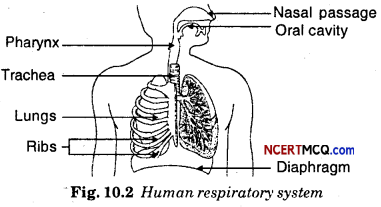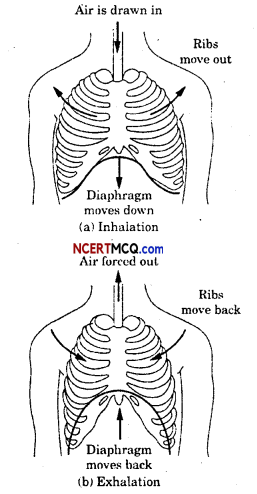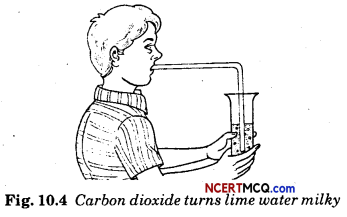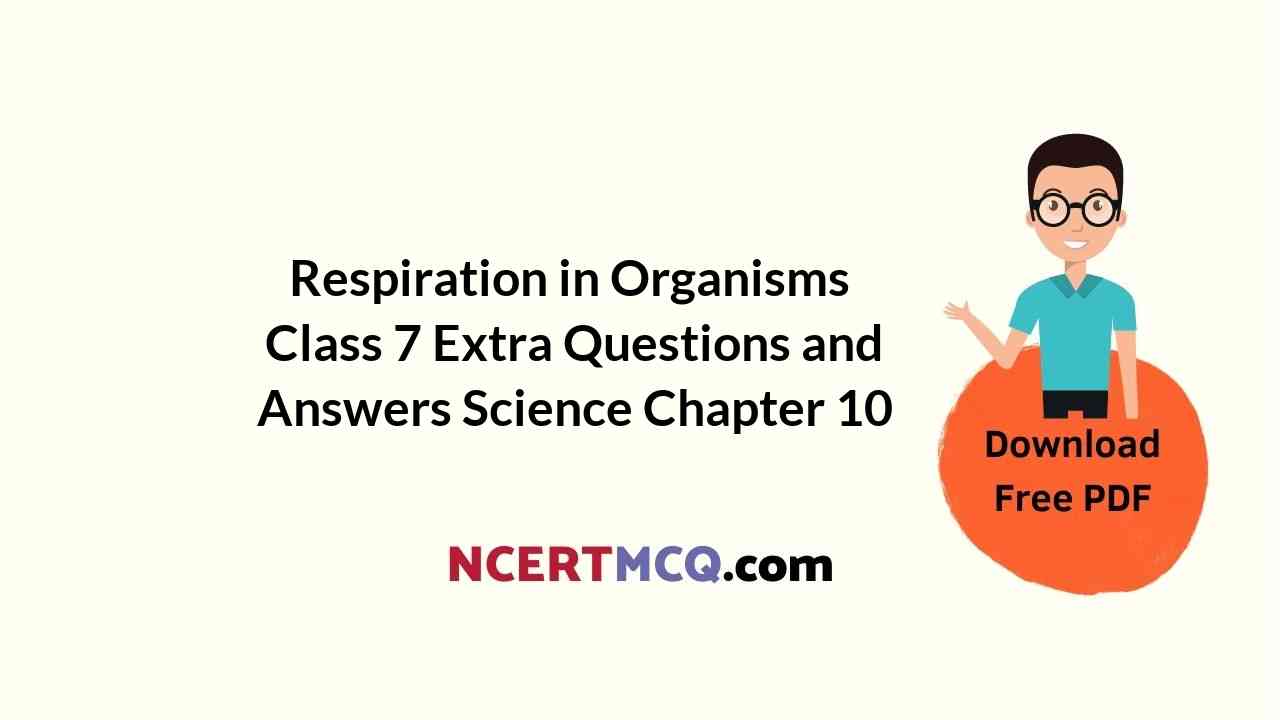Here we are providing Online Education for Respiration in Organisms Class 7 Extra Questions and Answers Science Chapter 10 was designed by subject expert teachers. https://ncertmcq.com/extra-questions-for-class-7-science/
Online Education for Class 7 Science Chapter 10 Extra Questions and Answers Respiration in Organisms
Respiration In Organisms Class 7 Extra Questions With Answers Question 1.
Where does cellular respiration take place?
Answer:
It takes place in the cells of organisms.
Class 7 Science Chapter 10 Extra Question Answer Question 2.
Write the equation for breakdown of food in aerobic respiration. With the use of oxygen
Answer:

Respiration In Organisms Class 7 Questions And Answers Question 3.
Write the equation for breakdown of food in anaerobic respiration. Without the use of oxygen
Answer:

Ncert Class 7 Science Chapter 10 Extra Questions Question 4.
What is a breath?
Answer:
A breath means one inhalation plus one exhalation.
![]()
Class 7 Respiration In Organisms Extra Questions Question 5.
What is the breathing rate of an average person at rest?
Answer:
On an average, an adult human being at rest breathes in and out 15-18 times in a minute.
Class 7 Science Chapter 10 Extra Questions Question 6.
How do ribs and diaphragm move during inhalation?
Answer:
During inhalation, ribs move up and outwards and diaphragm moves- downwards.
Class 7 Science Ch 10 Extra Questions Question 7.
What care should be taken during sneezing?
Answer:
When one sneezes, he/she should cover his/her nose so that the foreign particles expelled out are not inhaled by other persons.
Extra Questions On Respiration In Organisms Class 7 Question 8.
Which is the respiratory organ for earthworm?
Answer:
Skin.
Ncert Solutions For Class 7 Science Chapter 10 Extra Questions Question 9.
What is exhalation?
Answer:
Giving out of air rich in carbon dioxide is called exhalation.
Respiration In Organisms Extra Questions Question 10.
What are anaerobes? Give example.
Answer:
There are some organisms such as yeast that can survive in the absence of air. They are called anaerobes.
![]()
Respiration In Organisms Class 7 Extra Questions Question 11.
What is yeast? What is their use?
Answer:
Yeasts are single-celled organisms. They respire anaerobically and during this process yield alcohol. They are, therefore, used to make wine and beer.
Respiration Class 7 Extra Questions Question 12.
Why do you get muscle cramps after heavy exercise?
Answer:
The cramps occur when muscle cells respire anaerobically. The partial breakdown of glucose produces lactic acid. The accumulation of lactic acid causes muscle cramps.
Respiration In Organisms Class 7 Extra Questions And Answers Question 13.
Show the composition of inhaled and exhaled air.
Answer:
The percentage of oxygen and carbon dioxide inhaled and exhaled air :

Class 7 Chapter 10 Science Extra Questions Question 14.
How does anaerobic respiration occur in humans?
Answer:
During heavy exercise, fast running, cycling, walking for many hours or heavy weight lifting, the demand for energy is high. But the supply of oxygen to produce energy is limited. Then anaerobic respiration takes place in the muscle cells to fulfil the demand of energy :

Chapter 10 Science Class 7 Extra Questions Question 15.
Describe respiration in earthworm.
Answer:
Earthworms breathe through their skins. The skin of an earthworm feels moist and slimy on touching. Gases can easily pass through them.
Question 16.
Give a brief description of our respiratory system with diagram.
Answer:
Normally we take in air through our nostrils. When we inhale air, it passes through our nostrils into the nasal cavity. From the nasal cavity, the air reaches our lungs through the windpipe. Lungs are present in the chest cavity.

This cavity is surrounded by ribs on the sides. A large muscular sheet called diaphragm forms the floor of the chest cavity.
![]()
Question 17.
Draw diagrams to show movements of rib and diaphragm during breathing.
Answer:

Question 18.
Describe respiration in cockroach.
Answer:
A cockroach has small openings on the sides of its body. These openings are called spiracles. Internally, they have a network of air tubes called tracheae for gas exchange. Oxygen-rich air rushes through spiracles into the tracheal tubes, diffuses into the body tissue, and reaches every cell of the body. Similarly, carbon dioxide from the cells goes into the tracheal tubes and moves out through spiracles.
Question 19.
How does breathing take place?
Answer:
Breathing involves the movement of the diaphragm and the rib cage. During inhalation, ribs move up and outwards and diaphragm moves down. This movement increases space in our chest cavity and air rushes into the lungs. The lungs get filled with air. During exhalation, ribs move down and inwards, while diaphragm moves up to its former position. This reduces the size of the chest cavity and air is pushed out of the lungs.
Question 20.
List the similarities and differences between aerobic and anaerobic respiration.
Answer:
Similarities :
- Energy is released.
- Carbon dioxide is produced.
Differences :
- Anaerobic respiration does not require oxygen while aerobic respiration takes place in the presence of oxygen.
- Glucose is completely broken down into CO2 and water in aerobic respiration but not in anaerobic respiration.
Question 21.
Why do we often sneeze when we inhale a lot of dust-laden air?
Answer:
When we inhale a lot of dust-laden air often these particles get trapped, in the hair present in the nasal cavity. Then they irritate the lining of the cavity, as a result of which we sneeze. Sneezing expels these foreign particles from the inhaled air and a dust-free, clean air enters our body.
![]()
Question 22.
Boojho has seen in television programmes that whales and dolphins often come up to the water surface. They even release a fountain of water sometimes while moving upwards. Why do they do so?
Answer:
Whales and dolphins are mammals and they have lungs to breathe. For breathing, they have to come on the surface. During moving upward, they abruptly exhale air, which results into a fountain of water.
Experiment:
Aim: To show that exhaled air is rich in carbon dioxide.
Requirements: Freshly prepared lime water, bent glass pipe and test tube.
Procedure: 2 ml of freshly prepared lime water (clear solution) is taken in a test tube. Lime water is the common name for calcium hydroxide [Ca(OH)2]. Now, with the help of a bent pipe the exhaled air from mouth is blown.
Observation: Lime water turns milky.
Conclusion: The above observation confirms that exhaled air is rich in carbon dioxide.

Multiple Choice Questions
1. Breathing comprises of :
(i) inhaling O2 rich air and exhaling CO2 rich air.
(ii) inhaling CO2 rich air and exhaling O2 rich air.
(iii) only inhaling O2 rich air
(iv) only exhaling CO2 rich air.
Answer:
(i) inhaling O2 rich air and exhaling CO2 rich air.
2. When we release our breath after holding it for some time, we breathe heavily. Why is it so?
(i) The above statement is wrong.
(ii) It is just out of habit.
(iii) To compensate body requirements.
(iv) We breathe heavily for fun.
Answer:
(iii) To compensate body requirements.
![]()
3. Which of the following is correct in context to breathing rate?
(i) It is constant.
(ii) It changes according to the requirement of oxygen by the body.
(iii) It changes periodically.
(iv) It is constant in some organisms and changes periodically in others.
Answer:
(ii) It changes according to the requirement of oxygen by the body.
4. For which of the following task, your breathing rate is highest?
(i) After a brisk walk for 10 minutes.
(ii) After running fast 100 m.
(iii) At normal.
(iv) At rest.
Answer:
(ii) After running fast 100 m.
5. Drowsiness is due to :
(i) receiving sufficient oxygen by body.
(ii) receiving insufficient oxygen by body.
(iii) receiving excessive oxygen by body.
(iv) none of these.
Answer:
(ii) receiving insufficient oxygen by body.
6. Why we yawn when we are sleepy or drowsy?
(i) Out of habit.
(ii) To receive extra oxygen.
(iii) It is synchronized with drowsiness.
(iv) None of these.
Answer:
(ii) To receive extra oxygen.
7. Which of the following activities ‘ requires the highest breathing rate?
(i) Sleeping
(ii) Walking
(iii) Studying
(iv) Running.
Answer:
(iv) Running.
![]()
8. During inhalation, which of the following does not happen?
(i) Air is drawn in.
(ii) Ribs move out.
(iii) Lungs shrink.
(iv) Diaphragm moves down.
Answer:
(iii) Lungs shrink.
9. Take a wide plastic bottle. Remove the bottom. Get a y-shaped glass. Make a hole in the lid so that the tube may pass through it. To the forked end of the tube fix two deflated balloons. To the open base of the bottle tie a thin rubber using a large band. What does balloons and rubber represent respectively?
(i) Diaphragm, Lungs
(ii) Lungs, Diaphragm
(iii) Ribs, Diaphragm
(iv) Diaphragm, Ribs.
Answer:
(ii) Lungs, Diaphragm.
10. The change in the appearance of lime water to milky on exhalation in it, shows the presence of gas in the exhaled air.
(i) Oxygen
(ii) Carbon dioxide
(iii) Carbon monoxide
(iv) None of these.
Answer:
(ii) Carbon dioxide.
11. The percentage of oxygen and carbon dioxide respectively in inhaled air is :
(i) 21% oxygen, 4% CO2
(ii) 21% oxygen, 0.04% CO2
(iii) 16.4% oxygen, 4.4% CO2
(iv) 16.4% oxygen, 0.44% CO2
Answer:
(ii) 21% oxygen, 0.04% CO2.
12. The percentage of oxygen and carbon dioxide respectively in exhaled air is :
(i) 21% oxygen, 4% CO2
(ii) 21% oxygen, 0.04% CO2
(iii) 16.4% oxygen, 4.4% CO2
(iv) 16.4% oxygen, 0.44% CO2.
Answer:
(iii) 16.4% oxygen, 4.4% CO2.
![]()
13. The respiratory organ of insects, earthworm and fish respectively are :
(i) trachea, gills, moist skin
(ii) trachea, moist skin, gills
(iii) skin, trachea, gills
(iv) skin, gills, trachea
Answer:
(ii) trachea, moist skin, gills.
Keywords:
→ Aerobic respiration: When breakdown of glucose occurs with the use of oxygen, it is called aerobic respiration.
→ Anaerobic respiration: When food is broken down without using oxygen, it is called anaerobic respiration.
→ Breathing rate: The number of times a person breathes in a minute is termed as the breathing rate.
→ Cellular respiration: The process of breakdown of food in the cell with the release of energy is called cellular respiration.
→ Diaphragm: A largé, muscular sheet forming the floor of the chest cavity is called diaphragm.
→ Inhalation: The taking in of air rich in oxygen into the body is called inhalation.
→ Gills: Organ for breathing in fish.
→ Exhalation: Giving out air rich in carbon dioxide during respiration is called exhalation.
→ Spiracles: Small openings on the sides of insects’ body meant for respiration are known as spiracles.
→ Tracheae: Insects have a network of air tubes for gas exchange. It is called tracheae.
